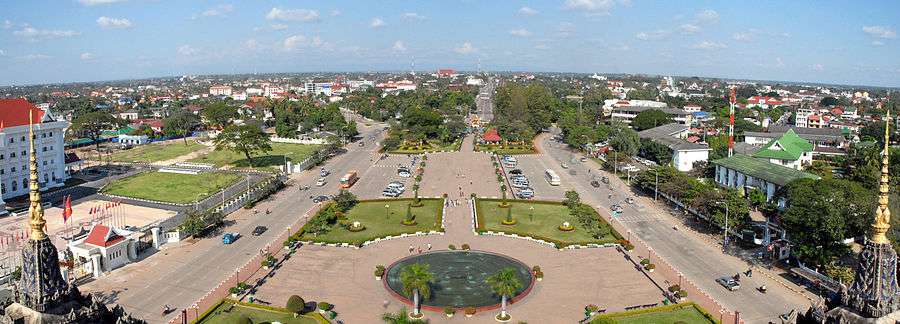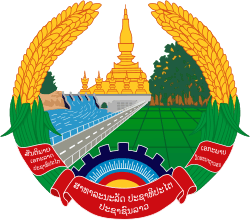Economy of Laos
The economy of Laos is a rapidly growing lower-middle income developing economy. Being one of four remaining socialist states, the Lao economic model resembles the Chinese socialist market and/or Vietnamese socialist-oriented market economies by combining high degrees of state ownership with an openness to foreign direct investment and private ownership in a predominantely market-based framework.[14][15]
 | |
| Currency | Lao Kip (LAK, ₭) |
|---|---|
| 1 October–30 September | |
Trade organizations | ASEAN, WTO |
Country group |
|
| Statistics | |
| Population | |
| GDP | |
| GDP rank | |
GDP growth |
|
GDP per capita | |
GDP per capita rank | |
GDP by sector |
|
| 3.3% (2020 est.)[4] | |
Population below poverty line | |
| 36.4 medium (2012)[7] | |
Labor force | |
Labor force by occupation |
|
| Unemployment | 9.4% (2017)[12] |
Main industries | Copper, tin, gold, and gypsum mining; timber, electric power, agricultural processing, rubber construction, garments, cement and tourism |
| External | |
| Exports | |
Export goods | wood products, electricity, coffee, tin, copper, gold and cassava |
Main export partners | |
| Imports | |
Import goods | machinery and equipment, vehicles, fuel, consumer goods |
Main import partners | |
FDI stock | |
Gross external debt | |
| Public finances | |
| −5.5% (of GDP) (2017 est.)[3] | |
| Revenues | 3.099 billion (2017 est.)[3] |
| Expenses | 4.038 billion (2017 est.)[3] |
| Economic aid | $0.4 billion (1999 est.) |
Foreign reserves | |
Following independence, Laos established a Soviet-type planned economy. As part of economic restructuring that aimed to integrate Laos into the globalized world market, Laos underwent reforms called the New Economic Mechanism in 1986 that decentralized government control and encouraged private enterprise alongside state-owned enterprises.[16] Currently, Laos ranks amongst the fastest growing economies in the world, averaging 8% a year in GDP growth.[17] It is also forecasted that Laos will sustain at least 7% growth through 2019 as well.[18]
Key goals for the government includes pursuing poverty reduction and education for all children, also with its initiative to become a "land-linked" country. This is showcased through the ongoing construction of the nearly $6 billion high-speed rail from Kunming, China to Vientiane, Laos. The country opened a stock exchange, the Lao Securities Exchange in 2011, and has become a rising regional player in its role as a hydroelectric power supplier to neighbors such as China, Vietnam and Thailand. In the current period, the economy of Laos relies largely on foreign direct investment to attract the capital from overseas to support its continual economic rigorousness. The long-term goal of the Lao economy as enshrined in the constitution is economic development in the direction of socialism by creating the material conditions to move towards socialism.[19]
Despite rapid growth, Laos remains one of the poorest countries in Southeast Asia.[20][21] A landlocked country, it has inadequate infrastructure and a largely unskilled work force. Nonetheless, Laos continues to attract foreign investment as it integrates with the larger ASEAN Economic Community, its plentiful, young workforce, and favorable tax treatment.
Economic history
With the overthrow of the Laotian monarchy in 1975, the Pathet Lao's communist government instituted a planned economy of the Soviet-style command economy system, replacing the private sector with state enterprises and cooperatives; centralizing investment, production, trade, and pricing; and creating barriers to internal and foreign trade.
Seizure of power by the Communists also resulted in a withdrawal of mainly American external investment, on which the country had become greatly dependent as a result of the destruction of domestic capital during the Indochina Wars.[22]
Within a few years, the PDR Lao government realized these types of economic policies were preventing, rather than stimulating, growth and development. No substantive reform was introduced, however, until 1986 when the government announced its "new economic mechanism" (NEM). Initially timid, the NEM was expanded to include a range of reforms designed to create conditions conducive to private sector activity.
Prices set by market forces replaced government-determined prices. Farmers were permitted to own land and sell crops on the open market. State firms were granted increased decision-making authority and lost most of their subsidies and pricing advantages. The government set the exchange rate close to real market levels, lifted trade barriers, replaced import barriers with tariffs, and gave private sector firms direct access to imports and credit.
With the growing unrest in Eastern Europe and the Soviet Union, in 1989, the PDR Lao government reached agreement with the World Bank and the International Monetary Fund on additional reforms. The government agreed to introduce fiscal and monetary reform, promote private enterprise and foreign investment, privatize or close state firms, and strengthen banking. It also agreed to maintain a market exchange rate, reduce tariffs, and eliminate unneeded trade regulations. A liberal foreign investment code was enacted and appears to be slowly making a positive impact in the market. Enforcement of intellectual property rights is governed by two Prime Minister's Decrees dating from 1995 and 2002.[23]
In an attempt to stimulate further international commerce, the PDR Lao government accepted Australian aid to build a bridge across the Mekong River to Thailand. The "Thai-Lao Friendship Bridge", between Vientiane Prefecture and Nong Khai Province, Thailand, was inaugurated in April 1994. Although the bridge has created additional commerce, the Lao government does not yet permit a completely free flow of traffic across the span.
These reforms led to economic growth and an increased availability of goods. However, the 1997 Asian Financial Crisis, coupled with the Lao government's own mismanagement of the economy, resulted in spiraling inflation and a steep depreciation of the kip, which lost 87% of its value from June 1997 to June 1999. Tighter monetary policies brought about greater macroeconomic stability in FY 2000, and monthly inflation, which had averaged about 10% during the first half of FY 1999, dropped to an average 1% over the same period in FY 2000.
In FY 1999, foreign grants and loans accounted for more than 20% of GDP and more than 75% of public investment.
The economy continues to be dominated by an unproductive agricultural sector operating largely outside the money economy and in which the public sector continues to play a dominant role. Still, a number of private enterprises have been founded and some are quite successful in industries such as handicrafts, beer, coffee and tourism. With United Nations, Japanese, and German support, a formerly state-controlled chamber of commerce aims to promote private business: the Lao National Chamber of Commerce and Industry and its provincial subdivisions.[24]
The latest round of state-owned enterprise reform in 2019 aims to establish SOEs as profitable ventures that can become efficient and sustainable sources of income for the national treasury. These measures include closing unproductive enterprises, ensure businesses in which the state has investments are reformed into profitable ventures, and reduce corruption. As of 2019, the State-Owned Enterprise Development and Insurance Department of the Lao government has 183 enterprises under its supervision.[25]
Agriculture
Agriculture, mostly subsistence rice farming, dominates the economy, employing an estimated 85% of the population and producing 51% of GDP. Domestic savings are low, forcing Laos to rely heavily on foreign assistance and concessional loans as investment sources for economic development.
Agricultural products include sweet potatoes, vegetables, corn, coffee, sugarcane, tobacco, cotton, tea, peanuts, rice; water buffalo, pigs, cattle, poultry.
In mid-2012, the Laos government issued a four-year moratorium for new mining projects. The reasons cited were environmental and social concerns relating to the use of agricultural land.[26]
Tourism
Tourism is the fastest growing industry in the economy and plays a vital role in the Lao economy. The government opened Laos to the world in the 1990s, and continues to be a popular destination amongst tourists.[27]
Other statistics
GDP: purchasing power parity - $14.2 billion (2009 est.)
Exchange rate - kips (LAK) per US dollar - 8,556.56 (2009), 8,760.69 (2008), 9,658 (2007), 10,235 (2006), 10,820 (2005)
- Oil - production:
- 0 bbl/d (2009 est.)
- Oil - consumption:
- 3,000 bbl/d (480 m3/d) (2009 est.)
- Oil - exports:
- 0 bbl/d (2007 est.)
- Oil - imports:
- 3,080 bbl/d (490 m3/d) (2007 est.)
Of the total foreign investment in Laos in 2012, the mining industry got 27% followed by electricity generation which has 25% share.[26]
References
- "World Economic Outlook Database, April 2019". IMF.org. International Monetary Fund. Retrieved 29 September 2019.
- "World Bank Country and Lending Groups". datahelpdesk.worldbank.org. World Bank. Retrieved 29 September 2019.
- "The World Factbook". CIA.gov. Central Intelligence Agency. Retrieved 19 June 2019.
- "World Economic Outlook Database, October 2019". IMF.org. International Monetary Fund. Retrieved 20 October 2019.
- "Global Economic Prospects, June 2020". openknowledge.worldbank.org. World Bank. p. 74. Retrieved 10 June 2020.
- "Poverty headcount ratio at $3.20 a day (2011 PPP) (% of population)". data.worldbank.org. World Bank. Retrieved 14 September 2019.
- "GINI index (World Bank estimate)". data.worldbank.org. World Bank. Retrieved 19 June 2019.
- "Human Development Index (HDI)". hdr.undp.org. HDRO (Human Development Report Office) United Nations Development Programme. Retrieved 11 December 2019.
- "Inequality-adjusted Human Development Index (IHDI)". hdr.undp.org. HDRO (Human Development Report Office) United Nations Development Programme. Retrieved 11 December 2019.
- "Labor force, total - Lao PDR". data.worldbank.org. World Bank. Retrieved 9 January 2020.
- "Employment to population ratio, 15+, total (%) (national estimate)". data.worldbank.org. World Bank. Retrieved 14 September 2019.
- "Unemployment, total (% of total labor force) (national estimate) - Lao PDR". openknowledge.worldbank.org. World Bank. Retrieved 9 January 2020.
- "Ease of Doing Business in Lao PDR". Doingbusiness.org. Retrieved 19 June 2019.
- "Laos - Market Overview". Export.gov. July 15, 2019. Retrieved September 25, 2019.
Laos is one of the world’s five remaining communist countries. The Lao economic model bears some resemblance to its Chinese and Vietnamese counterparts, in that it has implemented market-based economic practices while maintaining a high degree of state control and welcoming foreign direct investment (FDI). Laos is politically stable.
- "Chapter II: The Socio-Economic Regime" (PDF). Constitute. Constitute. 2003. Retrieved September 25, 2019.
All types of enterprises are equal before the laws and operate according to the principle of the market economy, competing and cooperating with each other to expand production and business while regulated by the State in the direction of socialism.
- "Laos".
- "The World Factbook — Central Intelligence Agency". www.cia.gov. Retrieved 2017-02-11.
- "Bloomberg Briefs". newsletters.briefs.bloomberg.com. Retrieved 2017-02-11.
- "Preamble" (PDF). Constitute. Constitute. 2003. Retrieved September 25, 2019.
During [the years] since the country has been liberated, our people have together been implementing the two strategic tasks of defending and building the country, especially the undertaking of reforms in order to mobilise the resources in the nation to preserve the people's democratic regime and create conditions to move towards socialism.
- Philip, Bruno (6 November 2012). "Laos, south-east Asia's new emerging economy". The Guardian. London.
- Oliver, Chris. "Laos marks first-day trade in new exchange". MarketWatch. Retrieved 2019-09-25.
- Baten, Jörg (2016). A History of the Global Economy. From 1500 to the Present. Cambridge University Press. p. 297. ISBN 9781107507180.
- Laos
- 8km.de, LNCCI
- "Laos to set state-owned enterprises on path to profitability". Asia News Network. Asia News Network. January 8, 2019. Retrieved September 25, 2019.
- "Vietnam leads investment in Laos". Investvine.com. 2013-02-26. Retrieved 2013-04-03.
- Slade, Maria (9 January 2011). "Stray-ing into Laos". The New Zealand Herald. Retrieved 11 September 2011.
External links
| Wikimedia Commons has media related to Economy of Laos. |
- Rice research in Lao PDR
- Rice Biodiversity in Lao PDR http://www.sdc.org.vn/index.php?navID=21483&langID=1]
